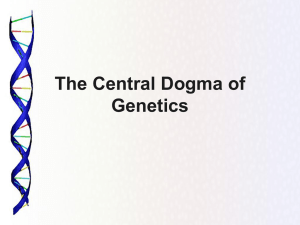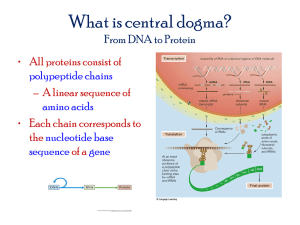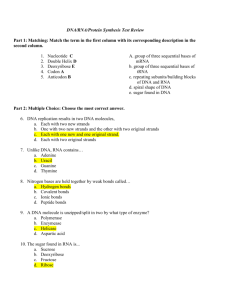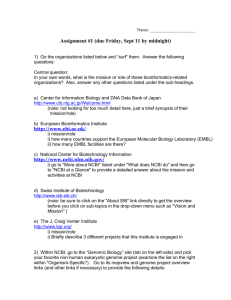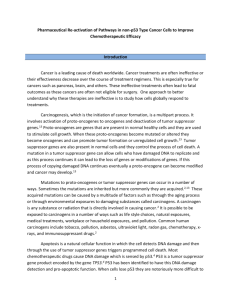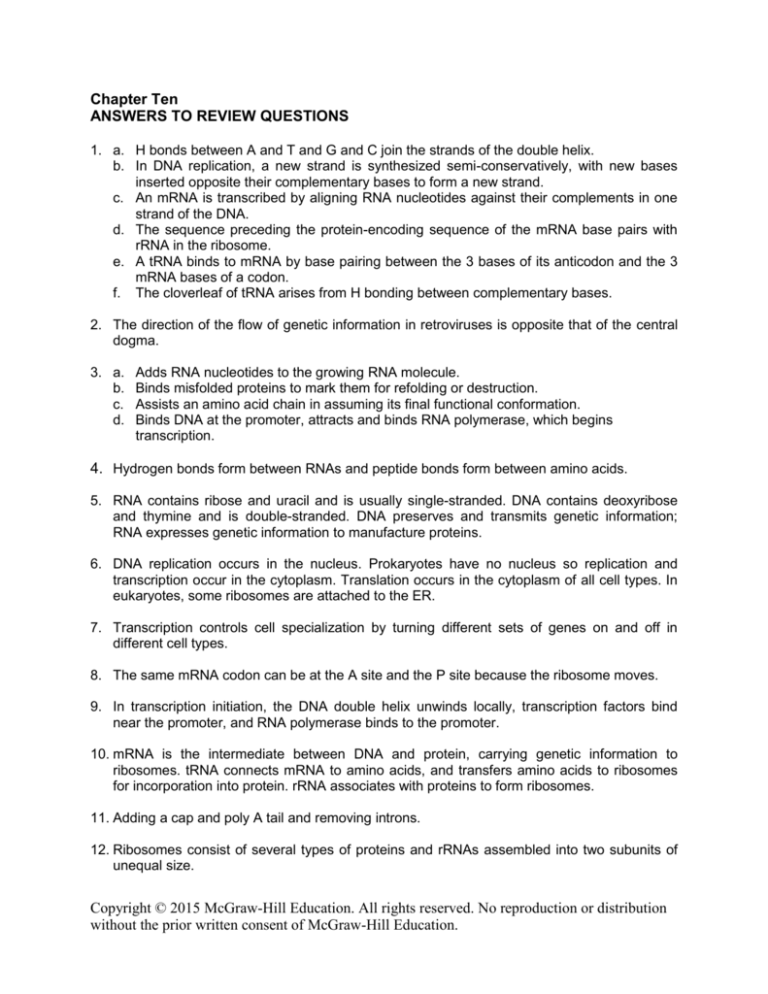
Chapter Ten
ANSWERS TO REVIEW QUESTIONS
1. a. H bonds between A and T and G and C join the strands of the double helix.
b. In DNA replication, a new strand is synthesized semi-conservatively, with new bases
inserted opposite their complementary bases to form a new strand.
c. An mRNA is transcribed by aligning RNA nucleotides against their complements in one
strand of the DNA.
d. The sequence preceding the protein-encoding sequence of the mRNA base pairs with
rRNA in the ribosome.
e. A tRNA binds to mRNA by base pairing between the 3 bases of its anticodon and the 3
mRNA bases of a codon.
f. The cloverleaf of tRNA arises from H bonding between complementary bases.
2. The direction of the flow of genetic information in retroviruses is opposite that of the central
dogma.
3. a.
b.
c.
d.
Adds RNA nucleotides to the growing RNA molecule.
Binds misfolded proteins to mark them for refolding or destruction.
Assists an amino acid chain in assuming its final functional conformation.
Binds DNA at the promoter, attracts and binds RNA polymerase, which begins
transcription.
4. Hydrogen bonds form between RNAs and peptide bonds form between amino acids.
5. RNA contains ribose and uracil and is usually single-stranded. DNA contains deoxyribose
and thymine and is double-stranded. DNA preserves and transmits genetic information;
RNA expresses genetic information to manufacture proteins.
6. DNA replication occurs in the nucleus. Prokaryotes have no nucleus so replication and
transcription occur in the cytoplasm. Translation occurs in the cytoplasm of all cell types. In
eukaryotes, some ribosomes are attached to the ER.
7. Transcription controls cell specialization by turning different sets of genes on and off in
different cell types.
8. The same mRNA codon can be at the A site and the P site because the ribosome moves.
9. In transcription initiation, the DNA double helix unwinds locally, transcription factors bind
near the promoter, and RNA polymerase binds to the promoter.
10. mRNA is the intermediate between DNA and protein, carrying genetic information to
ribosomes. tRNA connects mRNA to amino acids, and transfers amino acids to ribosomes
for incorporation into protein. rRNA associates with proteins to form ribosomes.
11. Adding a cap and poly A tail and removing introns.
12. Ribosomes consist of several types of proteins and rRNAs assembled into two subunits of
unequal size.
Copyright © 2015 McGraw-Hill Education. All rights reserved. No reproduction or distribution
without the prior written consent of McGraw-Hill Education.
13. An overlapping code constrains protein structure because certain amino acids would always
be followed by the same amino acids in every protein.
14. A 2-nucleotide code would encode 16 different amino acids, and there are 20 in life.
15. Transcription and translation recycle tRNAs and ribosomes. Many transcripts are made at a
time, and mRNAs are used over and over.
16. The amino acid sequence determines a protein's conformation by causing attractions and
repulsions between different parts of the molecule.
17. The primary structure creates attractions and repulsions between different parts of the
molecule. This results in a secondary structure of helices, sheets, or various distinct shapes
which give a larger tertiary structure. When more than one polypeptide unit bonds, a
complex quaternary structure forms which may be large.
18. A protein is “infectious” when it converts another non-infectious protein into the infectious
conformation with touch.
ANSWERS TO APPLIED QUESTIONS
1. A A U G U G A A C G A A C U C U C A G
2. C G A T A G A C A G T A T T T T C T C C T
3. Answers combine his (CAU or CAC), ala (CGU, GCC, GCA, GCG), arg (CGU, CGC, CGA,
CGG), ser (AGU, AGC, AGA, AGG), leu (CUU, CUC, CUA, CUG), val (GUC, GUG) and cys
(UGU, UGC).
4. Several answers are possible because of the redundancy of the genetic code. One answer
is: C A T A C C T T T G G G A A A T G G
5. There is only one genetic code.
6. 26,927
7. 125, but this doesn’t account for synonymous codons.
8. 1
9. Alternative splicing of the insulin receptor pre-mRNA.
10. The jarring motions that happen during football and combat may cause and then stabilize a
protein capable of forming prions to do so. As prions clog proteasomes, other types of
proteins can no longer be processed either, leading to brain degeneration.
11. a. G A A A A C C U U
b. glu-asn-leu
12. a. AAA to ACA
b. UCA to CUA
c. GCU to GUU
Copyright © 2015 McGraw-Hill Education. All rights reserved. No reproduction or distribution
without the prior written consent of McGraw-Hill Education.
13. a. nonsynonymous
b. GAU to AAU and GAC to AAC
c. in the brain
ANSWERS TO WEB ACTIVITIES
1. Many technical articles are behind paywalls, but students can answer the question using the
abstracts at NCBI.
Alzheimer
disease:
disrupted
protein
repair
and
oxidation.http://www.ncbi.nlm.nih.gov/pubmed/21383047
degradation
and
protein
Parkinson disease: protein misfolding and aggregation, resulting in inclusion bodies and other
aggregates within cells http://www.ncbi.nlm.nih.gov/pubmed/15564047
Huntington disease: clearance of Huntington protein.
http://www.ncbi.nlm.nih.gov/pubmed/21145396
ALS: proteasomes, not autophagy in lysosomes, causes ALS.
http://www.ncbi.nlm.nih.gov/pubmed/23095749
Lewy body dementia: a proteasome component is reduced in LBD but not in the similar
Alzheimer disease. http://www.ncbi.nlm.nih.gov/pubmed/18401540
ANSWERS TO CASE STUDIES AND RESEARCH RESULTS
1. a. Shortens b. No change. c. Shortens d. Lengthens. e. No protein made
2. Alternate splicing of pre-mRNA.
3. tRNA
4. A prion formed and became active.
Copyright © 2015 McGraw-Hill Education. All rights reserved. No reproduction or distribution
without the prior written consent of McGraw-Hill Education.





